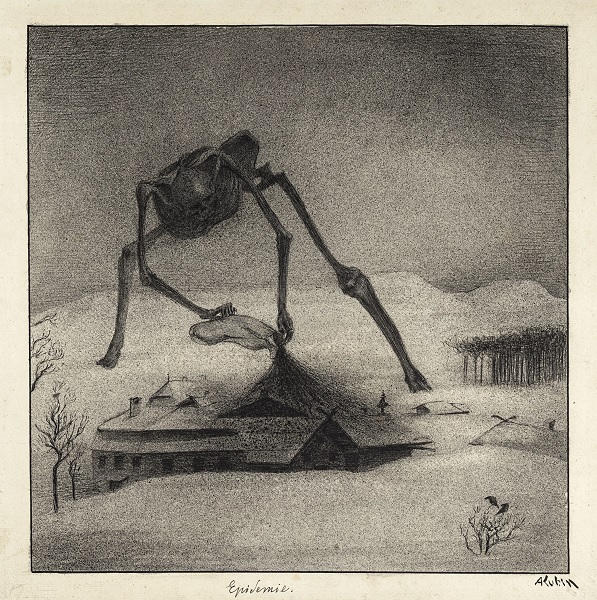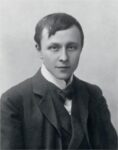
Alfred Kubin
Austrian, 1877-1959
The Epidemic (Die Epidemie), 1903
facsimile print
17 5/16 × 13 3/8 in.
SBMA, Museum Purchase, Alfred Moir Endowment Fund
2022.2.13

Kubin Photo: Nicola Perscheid (1904)
“Perhaps life is just that: a dream and fear.” - Alfred Kubin, Diary, 1939
COMMENTS
Alfred Kubin’s "Epidemie", executed circa 1901-02, conveys the figure of death in a spider-like form, plaguing a secluded house in the depth of winter and exuding the atmosphere of suppression and terror. "Epidemie" demonstrates Kubin’s mastery over the medium of ink, powerfully rendering the dark realms of his subconscious and nightmarish visions of doom. The present work was amongst a selection of drawings chosen for the Weber-Mappe in 1903, a portfolio of fifteen reproductions published by Hans von Weber; these characteristic pen and ink drawings from 1898 to 1903 are the most esteemed of Kubin's entire œuvre.
Kubin was a founding member of Der Blaue Reiter, sharing the group’s endeavour to transcend art to a spiritual plane. He was close friends with Paul Klee and corresponded with artists and philosophers of his day but also followed his own artistic path. In his autobiography, writing about his engagement with Schopenhauer’s philosophy, Kubin states: ‘In my desperate mood I found his pessimistic "Weltanschauung" [worldview] the only correct one, and I reveled in his ideas – with the consequence that my universal discontent only grew greater’ (A. Kubin, The Life and Art of Alfred Kubin, 1917, p. 13).
Like the Symbolist artists Odilon Redon, Max Klinger and Félicien Rops, Kubin was inspired by the philosophy of Nietzsche and Schopenhauer and the literature of Dostoyevsky and Poe, which offered countless points of departure for artists who agonized over the human condition. The influence of Charles Baudelaire’s Correspondences is particularly striking for such Symbolist artists and especially in relation to the physical and natural elements giving access to the spiritual realm. The present work is evocative of works by Redon's works, an artist much admired by Kubin and a source of inspiration. Redon’s noirs, and especially his nine lithographs "Les Origines" of 1883 recall ideas of the animal and the human, metamorphosis, life and death, black and white - themes and tropes predominantly employed by both artists. Kubin experiments with shadows and juxtaposed figures, playing with the surface of the sheet, shifting from a flat one-dimensional to a two-dimensional background, foreground and background. Ambiguities of space, perspective and light are implied, alongside the opposing qualities of health and sickness as well as life and death.
Two of Kubin's most frequent themes are death and the eternal wanderer. Paul Klee once remarked that Kubin interpreted the world as ‘poison’ (quoted in James H. Mitchell, 'Alfred Kubin', in Art Journal, vol. 28, no. 4, summer, 1969, p. 399). Evidently for Kubin, only the most grotesque creatures could thrive on the bitter concoction called ‘life’; gigantic insects, serpentine and spidery creatures comprise his fantastical imagery, all reflecting the frightful menagerie of a nightmare. Kubin never underestimated the value of dreams and he studied the literature on the subject, all the while employing his own subconscious to dictate his art. Kubin's style reflects a distorted world, unsure of its bearings and stupefied by reality. His lines are quick and seemingly frantic, signs of impending violence. Drawings like Epidemie burst on us like dreams and they seem to possess, as dreams do, the qualities of pace and irreversibility.
https://www.sothebys.com/en/auctions/ecatalogue/2019/impressionist-modern-art-evening-sale-l19006/lot.4.html
